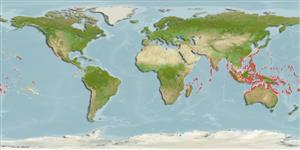Environment: milieu / climate zone / intervalo de profundidade / distribution range
Ecologia
marinhas associadas(os) a recifes; não migratória; intervalo de profundidade 1 - 25 m (Ref. 9710). Tropical; 32°N - 24°S
Indo-Pacific: East Africa south to Aliwal Shoal, South Africa (Ref. 4421) and east to Fiji, north to southern Japan, south to the southern Great Barrier Reef and New Caledonia. Recently recorded from Tonga (Ref. 53797). Replaced by Paraluteres arquat in the Red Sea.
Tamanho / Peso / Idade
Maturidade: Lm ? range ? - ? cm
Max length : 11.0 cm TL macho/indeterminado; (Ref. 4421)
Descrição breve
Chaves de identificação | Morfologia | Morfometria
Espinhos dorsais (total) : 2; Raios dorsais moles (total) : 25 - 28; Espinhos anais: 0; Raios anais moles: 22 - 25. Ranges from pale greenish to dirty white in color; blackish-brown saddles above; normally with a round dark blotch above origin of anal fin; soft dorsal and anal fins hyaline, tips dusky; caudal fin yellowish (Ref. 4421).
Body shape (shape guide): short and / or deep.
Inhabit clear lagoon and seaward reefs to at least 25 meters (Ref. 5503). Solitary or in small groups (Ref. 9710). Adults usually in pairs, but sometimes seen in small aggregations (Ref. 48637). Mimic the poisonous puffer, Canthigaster valentini which it greatly resembles. Feed on eggs, gastropods and grazes the substrate (Ref. 5503, 48637).
Life cycle and mating behavior
Maturidade | Reprodução | Desova | Ovos | Fecundidade | Larvas
Myers, R.F., 1991. Micronesian reef fishes. Second Ed. Coral Graphics, Barrigada, Guam. 298 p. (Ref. 1602)
Categoria na Lista Vermelha da IUCN (Ref. 130435: Version 2025-1)
Utilização humana
Ferramentas
Relatórios especiais
Descarregue XML
Fontes da internet
Estimates based on models
Preferred temperature (Ref.
123201): 25.2 - 29.3, mean 28.4 °C (based on 2764 cells).
Phylogenetic diversity index (Ref.
82804): PD
50 = 0.7500 [Uniqueness, from 0.5 = low to 2.0 = high].
Bayesian length-weight: a=0.01995 (0.00956 - 0.04164), b=2.93 (2.76 - 3.10), in cm total length, based on LWR estimates for this (Sub)family-body shape (Ref.
93245).
Nível Trófico (Ref.
69278): 2.7 ±0.44 se; based on food items.
Resiliência (Ref.
120179): Elevada, tempo mínimo de duplicação da população menor que 15 meses (Preliminary K or Fecundity.).
Fishing Vulnerability (Ref.
59153): Low vulnerability (10 of 100).
🛈
Nutrients (Ref.
124155): Calcium = 91.9 [39.7, 238.6] mg/100g; Iron = 0.901 [0.405, 2.114] mg/100g; Protein = 17.9 [15.6, 20.1] %; Omega3 = 0.11 [0.05, 0.23] g/100g; Selenium = 27.5 [12.9, 64.2] μg/100g; VitaminA = 72 [20, 274] μg/100g; Zinc = 1.79 [1.13, 2.88] mg/100g (wet weight);
